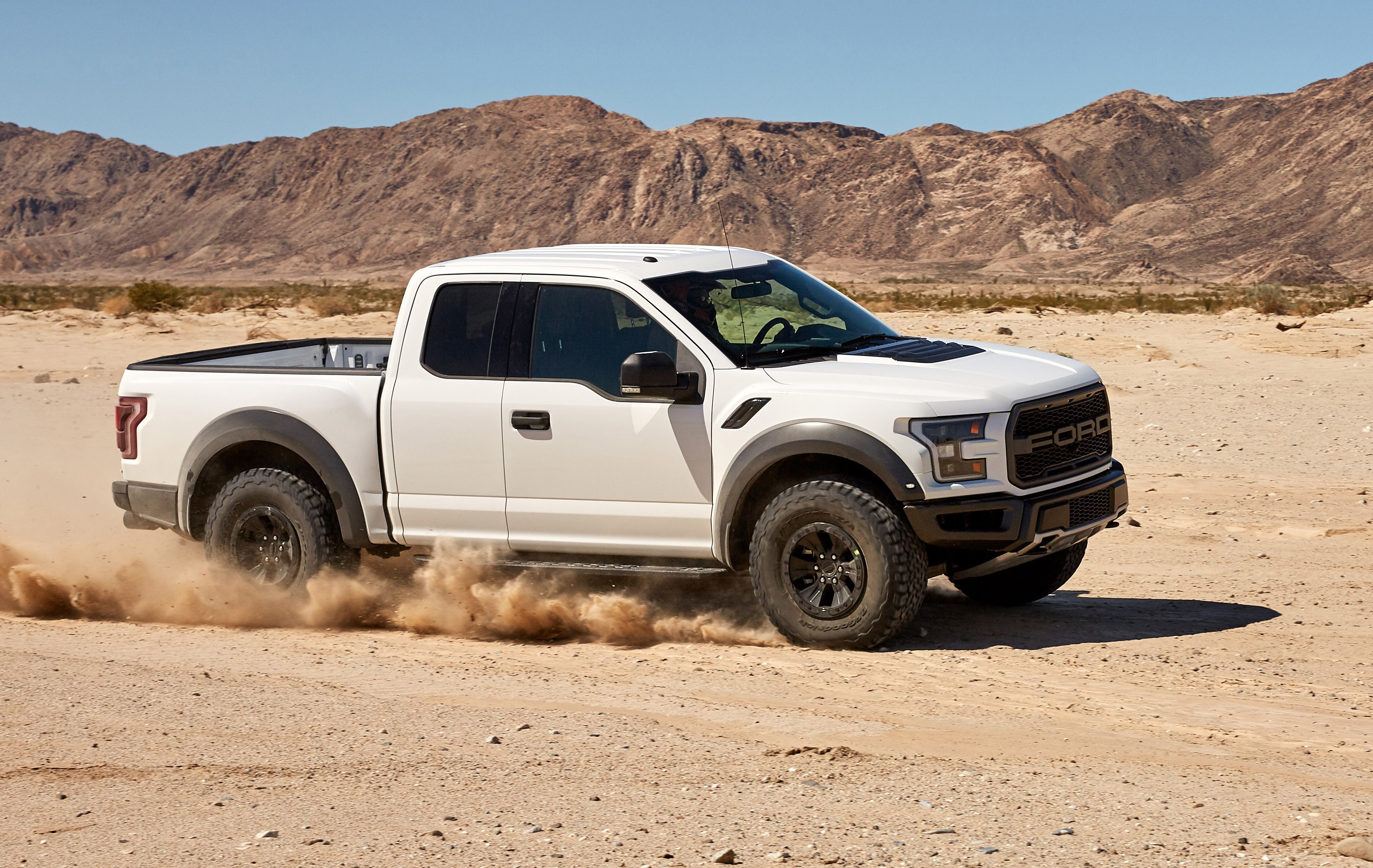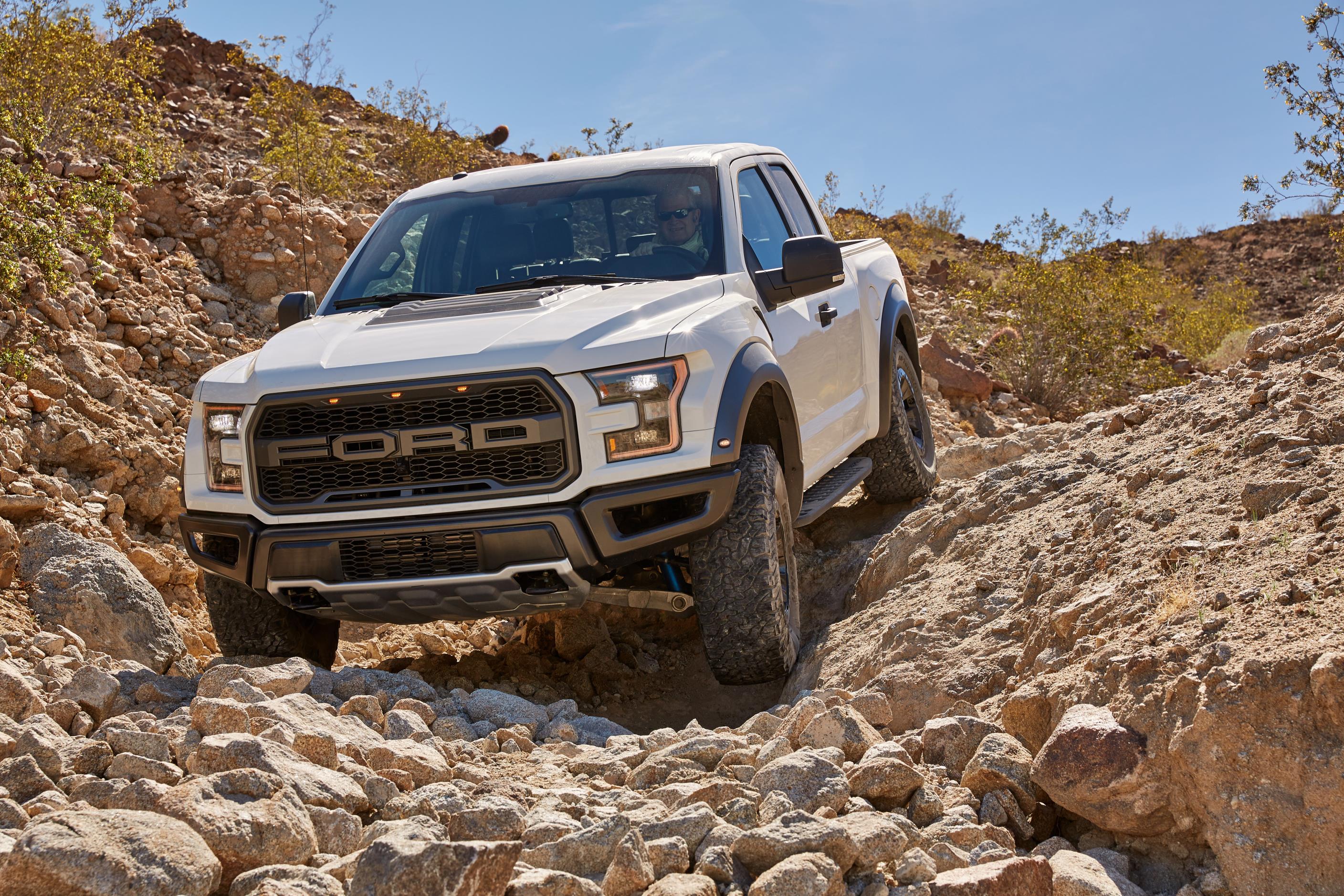
450 HORSEPOWER, 510 LB.-FT. OF TORQUE, IMPROVED FUEL ECONOMY
- All-new F-150 Raptor combines more power and torque with a 500-pound weight reduction and advanced powertrain control technology to deliver the ultimate high-performance off-road pickup
- Second-generation 3.5-liter high-output EcoBoost® engine produces 450 horsepower and 510 lb.-ft. of torque, plus a 23 percent improvement in EPA-estimated combined fuel economy
- Advanced 10-speed transmission enables Raptor customers to enjoy exhilarating performance and efficiency both on- and off-road
DEARBORN, Mich., Sept. 29, 2016 – Ford Motor Company, America’s truck leader, today announced horsepower and torque ratings for the all-new 2017 F-150 Raptor that will continue to position the ultimate high-performance off-road pickup in a class by itself.
Equipped with the all-new 3.5-liter twin-turbo high-output EcoBoost® engine, the Raptor churns out 510 lb.-ft. of torque and 450 horsepower across a wide power band.
Mated to an all-new Ford-built 10-speed transmission and exclusive transfer case – and managed by a six-mode Terrain Management System™ – the 2017 F-150 Raptor makes good on its promise to deliver an exhilarating off-road performance truck and even more bragging rights with a base MSRP less than $50,000.
“Raptor was designed to be a no-compromise, off-road performance machine,” said Matt Tranter, Ford Performance engineering supervisor. “That is why we made the switch from the cast-iron V8 to the aluminum block, high-output GTDI V6 EcoBoost engine that our team tuned to add 39 horsepower and 76 lb.-ft. of torque for today’s Raptor.”
Using the same high-strength, military-grade aluminum alloy body and a fully boxed high-strength steel frame as the current F-150 trucks, the 2017 Raptor is up to 500 pounds lighter than the 2014 model. Combined with a new high-output EcoBoost engine and 10-speed transmission, the 2017 Raptor delivers a 21 percent improved average torque-to-weight ratio and a 23 percent improvement in EPA-rated combined fuel economy compared with the previous generation Raptor.
EPA estimated fuel economy ratings for the 2017 F-150 Raptor are 15 mpg city, 18 mpg highway and 16 mpg combined. Actual mileage will vary.
Further building on the power-to-weight benefits, the 2017 Raptor delivers more low-RPM torque and better optimized power bands and shift points across all two-wheel drive and four-wheel drive modes thanks to the 10-speed transmission and torque-on-demand transfer case.
“The torque-on-demand transfer case and six-mode Terrain Management System is unique to Raptor in the Ford family of vehicles,” Tranter said. “It gives you the benefit of a clutched all-wheel-drive system for easy around-town maneuverability in bad weather. Then, there’s Baja Mode, which automatically engages a mechanically locked 4X4 high, and optimizes throttle response, shifting and boost control to provide improved off-road capability. That’s definitely drawing a line in the sand.”
All-new 3.5-liter high-output EcoBoost engine
Within performance circles, Ford’s EcoBoost engine has gained a following among truck enthusiasts and racing fans alike. Already robust and efficient, Ford developed the second-generation 3.5-liter EcoBoost, which the Ford Performance team then tuned specifically for the new Raptor.
Key 3.5-liter EcoBoost engine improvements include a new twin direct and port-fuel injection strategy, stronger and lighter crank and valvetrain components, a redesigned twin-turbocharger system with electronic wastegate, and a redesigned valvetrain and variable-displacement oil pump.
Among the high-output EcoBoost performance enhancements for Raptor are more aggressive turbo compressors with increased boost calibrations, cast stainless steel manifolds and full dual exhaust, oil-cooled pistons and more aggressive engine control calibrations.
“Looking at the torque curve of the Raptor’s EcoBoost engine, you see the twin turbos spool quicker for faster time to torque – it hammers quick and keeps delivering torque for a more brawny feel than its V8 predecessor,” said Al Cockerill, Raptor’s powertrain development engineer.
All-new 10-speed automatic transmission
The all-new 10-speed automatic transmission, standard on the 2017 Raptor, features Auto Start-Stop and an integrated electric pump that improve driving efficiency.
The transmission’s closer ratio between gears and Ford-patented hydraulic control system better optimize the power and torque curves of the new 3.5-liter high-output EcoBoost engine.
Raptor’s all-new adaptive shift algorithms monitor more than a dozen powertrain and driver control signals in real time – ensuring the right gear at the right time for an engaging driving experience, including Raptor’s normal, sport, weather, mud/sand, rock/crawl and Baja modes. In addition, a high-speed, one-way clutch allows for non-sequential shifting.
Weight savings play a key role in improved shift performance. The 10-speed gearbox – the first from Ford not to employ cast-iron components – uses advanced materials and alloys that result in less weight. Additionally, an integrated torque converter/turbine clutch helps shed more than two pounds, while also reducing the packaging footprint.


2017 F-150 RAPTOR TERRAIN MODES
The all-new Ford F-150 Raptor features six terrain modes designed to handle the most demanding terrains. From off-road rock crawling and desert running to on-road sport mode, Raptor is ready for any type of driving. Here’s a breakdown of each mode.
Normal
For everyday on-road driving duties, normal mode is a perfect balance of excitement, comfort and convenience.
Sport
Mountain passes are no longer just for Mustang, thanks to Raptor sport mode. For spirited on-road driving, sport mode increases throttle response and provides a sportier steering feel – along with quicker shifting. The transmission holds gears longer to keep you in the power band.
Weather
When road conditions are less than ideal, weather mode inspires confidence without compromising driving pleasure. Snow/wet mode automatically engages 4 Auto. AdvanceTrac, throttle response and the shift schedule are optimized for greater confidence in slippery conditions.
Mud/Sand
For tackling trails and other off-road treks, the mud/sand setting is your best friend. 4 High and the electronic locking differential automatically engage for driving over loose or soft ground, and optimized AdvanceTrac settings help Raptor keep its footing. Steering is set to comfort, which makes it easier to navigate along tight trails and over obstacles.
Baja
Baja mode is where Raptor eclipses the competition. Designed for high-speed desert running, Baja mode places the vehicle in 4 High, AdvanceTrac is programmed to the least intrusive settings, and the throttle map is adjusted for more linear power and improved engine response to give the hardcore off-road driver greater control. The transmission has quicker shifts and holds gears longer – keeping the vehicle in its power band.
Rock Crawl
This setting is for intense off-road driving and rock climbing at low speeds. Rock crawl prompts the driver to place the vehicle in 4 Low, the electronic locking differential is automatically engaged and AdvanceTrac is set to the least intrusive settings for optimum rock-climbing ability. Throttle modulation and transmission response are optimized for greater control. Additionally, the front camera allows the driver to see what’s right in front of the truck, and it can be kept on at speeds up to 15 mph.
Along with the individual AdvanceTrac settings tied to drive modes, Raptor continues the Ford Performance tradition of allowing the driver to program the system’s settings to match conditions and skill level. The driver can reduce traction control but keep stability control on with a single press of the electronic stability control button; or, by holding the button for five seconds, the driver can turn AdvanceTrac settings off.


